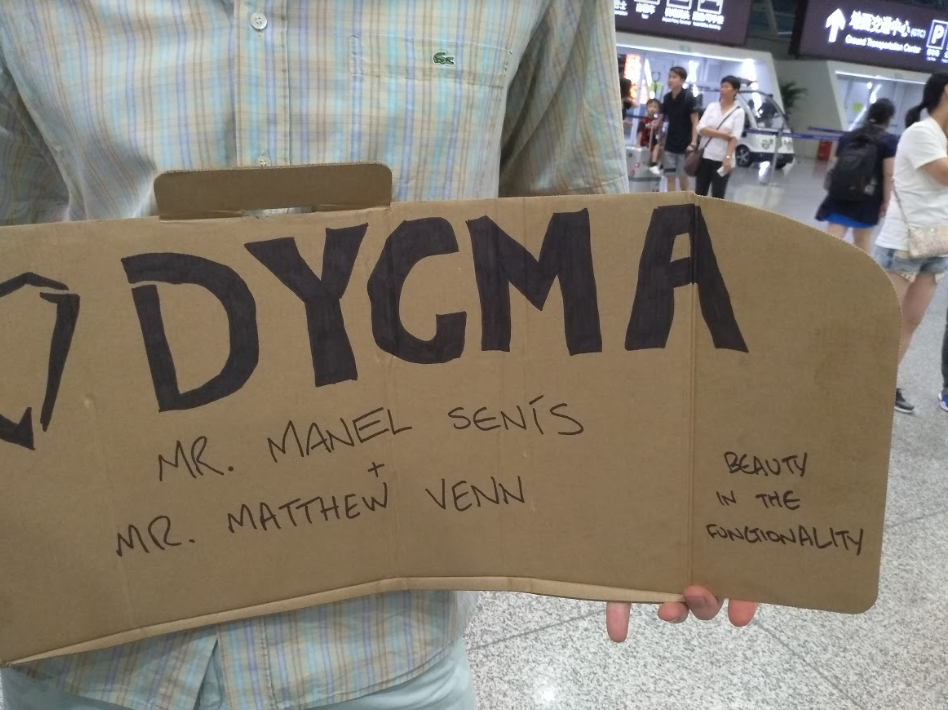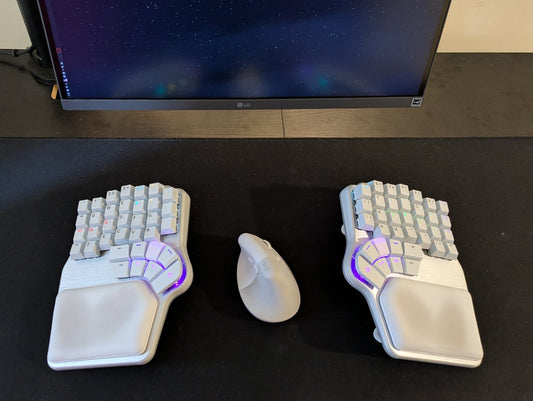Hey guys!
Finally, we have the updates on the latest development from our recent trip to China.

One of our Superbackers met Manel and Matt at the airport in Shenzhen ❤️
This post is the fourth of the Shenzhen trip series. Read more at:
This last trip to China was our fourth. The first trip was in July 2017, the second and third were in January and May of this year.
Prior to our most recent trip, we had already validated our industrial design. We had made the necessary iterations and had found the solutions we needed.
But when it came to the manufacturing process, there were some doubts. We were worried about quality control, timing, and other things. So during this trip, we made sure that we discussed all of these uncertainties with our partners. Thankfully, all things were clarified and we left China on a positive note.
Our first goal for this trip was to finalize everything related to the product design. This included the electronics and the quality of the metal finishing. Our second goal was to learn about the manufacturing process so we could create a planning schedule for the next steps.
The good news is now we know more about the reality of manufacturing processes. We have a clearer vision of the future. The bad news is that it will take longer than expected. Our manufacturers told us that the tooling for certain components would take as long as 45 days to create.
We have prepared a Gantt chart at the end of this update. But before we talk about that, we want to update you on what we’ve been working on at hand.
Silver Golden Prototype
We received the second Golden Prototype, the silver Raise. We were quite excited when we got it. This version has the ANSI layout.

Silver Raise with US PBT keycaps.
We still do not have the white special keycaps. The reason is that, as we mentioned in previous updates, these special keycaps will be made using a mold. That mold still needs to be created. For the photo above, we used the 3D-printed black special keycaps.
We also validated the white ABS keycaps. We were very happy with their quality.

Silver Raise with ABS keycaps.
We were also happy with the finishing and dimensions of the metal pins.
As some of you might remember, the metal pin solution for the joint was something that we had been working on for a long time. We needed it to be perfect. We wanted it to have the right feeling when detaching and attaching both sides. Once attached, we also needed enough magnetic force to keep the keyboard intact.
We are glad that the solution we had was reflected correctly in the silver Golden Prototype. After getting the correct feeling for the joint, we learned how we can maintain its quality during mass production.
We also validated the finishing of the metal cover of the Huble. The sandblasted finishing of both the silver and black covers look great!

Another metal component that we validated was the silver top case. Initially, the color of the top panel was too dark. So we had our suppliers change it to the platinum silver that we wanted. Both silver and black top cases look awesome.


Electronics
When in China, we visited our PCBA factory. We had to go through all the details with our PCBA partner to prepare everything for mass production.

We gave them our Huble test jig to follow and reproduce. We asked them to make as many test jigs as they can.
There should be a test jig for each PCB, and we have 5! As you might remember from Matt’s video, the Huble has one PCB and Raise has 4 PCBs, - 2 main PCBs and 2 low profile PCBs.
We are now working on the other test jigs. Once they’ve been tested and finalised, we will send them to China. Our partners will then reproduce them to use for mass production.
We also did the pre-test for our PCBs during our trip. By doing these pre-tests, we can be certain that our product will pass the real certification after mass production.
There were 3 tests. We passed 2 and failed 1. Now, we are working with a consultant to fix the issue. We still need to do some more tests. We will make a video and explain all of this in our next update.
Packaging
The packaging was something that we left till the end because we wanted the product to be properly defined first. Now we have all the details. We already defined the final dimensions of the packaging, the color, and the artwork.
The product will be enclosed in a PET plastic case for protection. The extra switches and keycaps will be in a separate case. There will be a foam on top of the cases to keep them all in place.

Tooling Agreement
We already defined all the legal agreements with all our suppliers. This included the Manufacturing Agreement, Tooling Agreement, Purchase Orders, Quality Control Agreement, etc. They needed to be translated and thoroughly discussed with all our partners. It was a long and difficult process but it was also very important.
Manufacturing Process
There are different phases to the manufacturing process. First is the EVT or engineering validation test. We already did this when we validated our industrial design.
Next is making the tooling. We need 15 different tooling for the Raise. While some of the tooling can be made in a week, some need 45 days to create.
After all the tooling have been created, we will test them (T1, T2, T3). This might take a week. If we find mistakes in T1, we will modify things and try again and do T2. T3 is for emergencies. Hopefully, it doesn’t get here and we can fix everything by T2.
Toff is a milestone. This is when we validate all tooling pieces as perfect and ready.
Next is the DVT or Design Validation Test, whichwill take 30 days. In this test, we will create 20-50 units of the Raise and validate them. If all is well, we will proceed to mass production.
If not, we would need to do the PVT or Production Validation Test. This will take another 30 days. We will only do this test if we still see numerous problems after the DVT. We are hoping that we won't need to go through with this anymore.
If everything is good in the Toff, we should be able to test everything in the DVT and begin mass production afterward.
However, we also have to take into account the Chinese New Year. This will be a 3-week holiday for most people in China. We have to put some allowance during this time and assume that there will be no work.
After the DVT or PVT, we will start the mass production of the remaining units. This might take as long as 40 days; but optimistically speaking, it might take 30 days.
Then, shipment!
The Gantt charts below show 2 scenarios: the best case and the worst case.
Best scenario:
- We won’t need a long time to test the tooling.
- We won’t do T3.
- We won’t do the PVT.
- Mass production will take 30 days.
- Shipment will be at the end of March to mid-April.
Click here to open the chart.

Worst case scenario:
- Tooling testing will take longer.
- We will need to do the T3.
- We will need to do the PVT.
- Mass production will take 40 days.
- Shipment will be mid-May.
Click here to open the chart.

The Raise is a complex product. There are hundreds of variants because of the different switches, keycaps, and color that we offer. But our suppliers are optimistic. They think it won’t be hard to assemble.

When we learned about the timeline and how long it would take, we all felt a bit disheartened. But at the same time, we felt relieved that now we have a clearer vision of the manufacturing process. We will try our best to work as fast as we can. But we won’t rush the process if it will risk the quality of the final product. We've always said that we wanted to give you a high-quality product, and that's what we intend to do.
We will completely understand that some of you won't be able to wait that long. We will compensate in any way possible without a problem.
Everything that we’ve been through has been a great learning process. And we wouldn’t have been able to go through this if it weren’t for all of you, our backers. So thank you all for being with us and supporting us all this time.
You guys rock!









